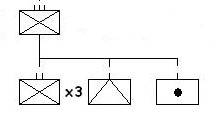The Pacific War Online Encyclopedia: Regiment (original) (raw)
| ![]() The Pacific War Online Encyclopedia | |
| -------------------------------------------------------------------------------- | |
The Pacific War Online Encyclopedia | |
| -------------------------------------------------------------------------------- | |

The regiment was the command echelon below the division and above the battalion in most American and Japanese divisions. In the British and Commonwealth armies, a regiment was a regional recruiting and training organization that was the repository of military tradition, and brigades were the command echelon below the division. A regiment was commandedby a colonel, with a lieutenant colonel as executive officer and a substantial staff.
United States. U.S. infantry regiments normally consisted of three infantry battalions with supporting units. The authorized strength in 1943 was 3118 men. Each of the three battalions had a strength of 871 men. In addition, there was a service company of 193 men, an antitank company of 165 men with 12 to 18 antitank guns, a cannon company of 118 men with six 105mm howitzers, and a headquarters company of 108 men. The U.S. Army also raised a large number of independent artillery and engineer regiments which were usually attached to a corps or army.
Marine regiments resembled Army infantry regiments, but had a weapons company in place of the antitank and cannon companies. Marine regiments had a greater tendency to operate independently of their parent division than Army regiments. This was unsurprising given the history and mission of the Marine Corps, which required greater flexibility.
A number of airborneregiments saw combat in the Pacific. These were either glider infantry regiments or parachute infantry regiments. These differed slightly in their weapons allocation as well as training, with the glider regiments having a larger allotment of Browning automatic rifles and mortars. Neither type of airborne regiment had the supporting elements of a regular infantry regiment.
A 1943 artillery regiment numbered 2160 men. These were organized into three medium artillery battalions of 509 men and 12 105mm howitzers each and a heavy artillery battalion of 519 men and 12 155mm howitzers. Supporting elements included a headquarters battery (company) of 114 men and two or three light observation aircraft.
In the Pacific, it was not uncommon for U.S. divisions to deploy into regimental combat teams. Each of these was composed of one of the three infantry regiments, plus approximately one third of the supporting elements of the division. Thus, a regimental combat team typically included a battalion of artillery and a company of engineers, perhaps further reinforced with a company of tanks, along with medical, signals, transport, and other supporting elements.
Britain. British regiments were regional recruiting and training organizations rich in military tradition. Their function was to provide trained battalions to the divisions. When a battalion was worn down in combat, it was pulled out of the line, and its regiment was expected to supply replacements, see that they were integrated into the battalion, and prepare the battalion for its return to the line.
Japan. Japaneseinfantry regiments were similar to American regiments, but dispersed most of their heavy weapons into their constituent battalions. They had a headquarters company in place of the antitank and cannon companies that retained a few infantry and antitank guns.
References
The Pacific War Online Encyclopedia © 2008, 2011, 2015 by Kent G. Budge. Index
